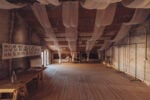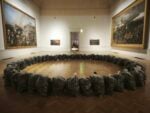Displacements. The Trouble With Being Human These Days
 (480x338).jpg)
Un dialogo tra artisti di nazionalità diverse accomunati dalla medesima condizione di viaggiatori.
Comunicato stampa
Il 26 marzo 2015 Ex Elettrofonica inaugura nei suoi spazi Displacements. The Trouble With Being Human These Days, un dialogo tra Ursula Burke, Iulia Ghita, Nikolaj Bendix Skyum Larsen, Diego Marcon, Timea Oravecz, artisti di nazionalità diverse accomunati dalla medesima condizione di viaggiatori.
Prendiamo un compasso, trafiggiamo con la punta il pallino rosso che indica Roma e facciamo scivolare la matita tracciando un cerchio perfetto che include l’Europa dell’est, i paesi del nord come la Danimarca, e del nord ovest come Irlanda, fino a lambire il mediterraneo. Ecco cosa c’è intorno a noi. Se leggiamo il giornale poi, nelle poche pagine che i nostri quotidiani dedicano alla politica estera, sappiamo anche cosa accade in questo cerchio da noi circoscritto. In poco tempo ci poniamo in una condizione di centralità rispetto ad un sistema di forze che operano, si muovono, si agitano tutt’intorno a noi.
Forse anche noi siamo in movimento, anche se di questo non ci sono prove.
Da questa semplice riflessione prende spunto l’idea di Displacements. The Trouble With Being Human These Days, che si prefigge di stimolare una riflessione sull’individuo in rapporto ad un territorio o ad una comunità attraverso i lavori di Ursula Burke, Iulia Ghita, Nikolaj Bendix Skyum Larsen, Timea Oravecz, tutti artisti in cui le tematiche politiche e sociali sono affrontate a partire dalla propria condizione personale, psicologica e, appunto, identitaria.
Dopo aver istituito un dialogo tra i lavori, accolti nella sala centrale in una prospettiva orizzontale di narrazione reciproca, la mostra impone una voce esterna. Attraverso il lavoro dell’unico italiano invitato, Diego Marcon, il progetto ribadisce la propria pretestuosa centralità ed esprime un commento, prendendo atto della nostra condizione di spettatori.
Il lavoro di Ursula Burke (1974) ha il potere di mettere in scena le tensioni che l’artista vive nel territorio che abita. Irlandese ma trapiantata a Belfast, Ursula vive la condizione politica del nord Irlanda, dove tutto è determinato e definito attraverso il conflitto, con un forte trasporto personale.
Iulia Ghita (1986) è un’artista di Bucarest che vive e lavora in Italia. La sua formazione pre-universitaria è stata svolta interamente in Romania e svela modalità di promozione degli artisti ancora dettate dal “sistema sovietico”, infatti i premi per la capacità pittorica a Iulia vengono assegnati sin dalla prima infanzia. Nei suoi lavori video la narrazione è ridotta all’osso, poche immagini ripetute, pochi suoni, suggeriscono tutto il suo mondo.
I lavori dell’artista danese Nikolaj Bendix Skyum Larsen (1971), esplorano l’intimità di persone coinvolte in situazioni politicamente ed emotivamente complesse legate alla convivenza sociale. Il suo linguaggio si esprime con video, installazioni, disegni e sculture. Ciò che contraddistingue la ricerca è la capacità di osservare il fenomeno dell’immigrazione dal punto di vista della la comunità accogliente: occidentale, colta, democratica, evoluta.
Diego Marcon (1985). Anche se il suo lavoro è visibile soprattutto in contesti legati all'arte, Marcon viene dal mondo del cinema. Il suo punto di partenza è un processo di registrazione audiovisiva della realtà, poi ri-editato e riscritto in una struttura filmica. I soggetti del suo lavoro e le forme che sviluppa si combinano per delineare un potente interrogativo sul cinema come linguaggio e come evento che ogni volta presenta in sé un mistero oscuro. L'artista arriva progressivamente a negare l'immagine, nel tentativo di svuotare uno spazio che potrebbe ospitare la superficie di una dimensione invisibile. Ma questo tentativo si risolve in un’eco.
L’artista ungherese Timea Oravecz (1975) per più di 15 anni ha vissuto in diversi paesi dell'Europa occidentale. Dopo un infanzia trascorsa sotto il regime socialista ungherese, è stata attratta da diversi approcci culturali e sociali, sviluppando un interesse specifico per il rapporto tra identità personale, cultura d’origine e necessità di integrazione. I suoi lavori fanno riferimento al contesto politico, sociale, storico e culturale in cui vive e si ispira alla sua vita quotidiana.
DURATA: Dal 27 marzo 2015 – al 13 maggio 2015
SEDE: Ex Elettrofonica - Vicolo di Sant’ Onofrio, 10 Roma
COME ARRIVARE: a pochi passi dall’ospedale Santo Spirito in Sassia e dall’ospedale Bambino Gesù, vicolo Sant’Onofrio si trova alle spalle di piazza della Rovere, sul Lungotevere.
ORARIO dal martedì al venerdì 15.00-19.00, sabato e lunedì su appuntamento, domenica chiuso.
INFORMAZIONI +39 06 64760163, [email protected], www.exelettrofonica.com
Displacements;
The Trouble with Being Human These Days
Ursula Burke IIulia GhitaINikolaj Bendix Skyum LarsenI Timea Oravecz IDiego Marcon
Opening: March 26th 2015, h. 6.30 pm
March 27th 2015 – May 13th 2015
Ex Elettrofonica, Vicolo Sant’ Onofrio, 10-11 Roma
PRESS RELEASE
On March 26th 2015 Ex Elettrofonica gallery will present Displacements; The Trouble WithBeing Human These Days, a dialogue betweenUrsulaBurke, IuliaGhita, Nikolaj Bendix Skyum Larsen, Diego Marcon, Timea Oravecz, artists of different nationalities that share the same position,astravelers.
Take a compass; piercethe tip into the red dot that marks Rome and slide the pencil around, tracing a perfect circle that encompasses Eastern Europe, countries in the North such as Denmark, in the Northwest such as Ireland, and finally, the Mediterranean.This is what surrounds us. If we read the few pages that our newspapers dedicate to foreign policy, we find what is happening in this circle we’ve drawn. For a short time we place ourselves in a position of centrality in the system of forces that act, move, and stir all around us. Perhaps we, too, are moving, even if there is no evidence of this.
Following the journey of our international artists we are returned home, with the work of the only Italian artist, Diego Marcon. By positioning the work within the local with an outward glance to the global, this exhibition attempts to raise questions in relation to how identity operates within a matrix of social, political and national forces.
Displacements; The Trouble with Being Human These Daysseeks to stimulate a reflection on the individual in relation to territory or community, through the works of Ursula Burke, Iulia Ghita, Nikolaj Bendix Skyum Larsen, Timea Oravecz, all artists who have addressed political and social themesbased on their own personal and psychological conditions, and their own identities.
Irish artist -Ursula Burke’s (1974) sculptural work sensitively deals with Representation and Identity within post-conflict Northern Ireland. Using a range of formal techniques drawn from the canon of fine art classicism, she works in dialogue between idealised versions of society expressed through the classical period and potential constructions of the ideal within contemporary, post-conflict, Northern Irish society.Northern Ireland as a region is consistently working towards peace; persistently speaking and striving to move towards an indeterminate point in the future where real, meaningful and lasting peace between tribal communities has been realized.
Iulia Ghita(1986) is an artist from Bucharest living in Rome. Her pre-university formation was conducted entirely in Romania and reveals a method of promoting artists that was still dictated by the “Soviet system”. Prizes for paintingskillwere awarded to Iulia from a young age. Upon comingto Italy to attend the Fine Arts Academy in Rome, she encountered a completely different reality. In her video works, the narration is minimal, withvery few repeated images andvery few sounds, which suggest her whole world.
The work of Danish artist Nikolaj Bendix Skyum Larsen (1971) explores the intimacy of people involved in politically and emotionally complex situations related to social coexistence. His language is expressed through video, installations, drawings, and sculptures. What distinguishes his research is the ability to observe the issue of immigration from the point of view of the welcoming community: Western, educated, democratic, and evolved.
Diego Marcon (1985). Though his work is visible above all in contexts tied to art, he comes from the world of cinema and his inquiry is based on video and images in movement, with a documentary approach. His starting point is a process of audio-visual recording of reality, later re-edited and rewritten into a filmic structure. The subjects of his work and the forms that develop combine to delineate a powerful interrogation of cinema as a language and as an event that each time presents in itself an obscure mystery. The artist progressively arrives to negate the image in itself, in the attempt to empty a space that might host the surface of an invisible dimension. But this attempt resolves itself into an echo.
The Hungarian artist Timea Oravecz (1975) has lived in various countries in Western Europe for over 15 years. After spending her childhood under the Hungarian socialist regime, she was attracted by different cultural and social approaches, developing a special interest for the relationship between personal identity, culture of origin, and need for integration. Her works refer to the political, social, historical and cultural context in which she lives and are inspired by her daily life.



